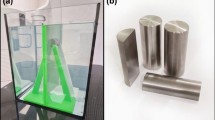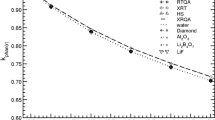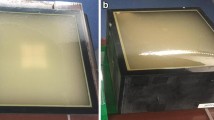Abstract
The aim of this study was to evaluate the accuracy of the new AcurosTM BV algorithm using well characterized LiF:Mg,Ti TLD 100 in heterogeneous phantoms. TLDs were calibrated using an 192Ir source and the AAPM TG-43 calculated dose. The Tölli and Johansson Large Cavity principle and Modified Bragg Gray principle methods confirm the dose calculated by TG-43 at a distance of 5 cm from the source to within 4 %. These calibrated TLDs were used to measure the dose in heterogeneous phantoms containing air, stainless steel, bone and titanium. The TLD results were compared with the AAPM TG-43 calculated dose and the Acuros calculated dose. Previous studies by other authors have shown a change in TLD response with depth when irradiated with an 192Ir source. This TLD depth dependence was assessed by performing measurements at different depths in a water phantom with an 192Ir source. The variation in the TLD response with depth in a water phantom was not found to be statistically significant for the distances investigated. The TLDs agreed with AcurosTM BV within 1.4 % in the air phantom, 3.2 % in the stainless steel phantom, 3 % in the bone phantom and 5.1 % in the titanium phantom. The TLDs showed a larger discrepancy when compared to TG-43 with a maximum deviation of 9.3 % in the air phantom, −11.1 % in the stainless steel phantom, −14.6 % in the bone phantom and −24.6 % in the titanium phantom. The results have shown that Acuros accounts for the heterogeneities investigated with a maximum deviation of −5.1 %. The uncertainty associated with the TLDs calibrated in the PMMA phantom is ±8.2 % (2SD).




Similar content being viewed by others
References
IAEA Technical Report Series 398 (2004) Absorbed dose determination in External Beam Radiotherapy: an International Code of Practice for Dosimetry based on standards of absorbed dose to water, Vienna
Haughey A, Coalter G, Mugabe K (2011) Evaluation of linear array MOSFET detectors for in vivo dosimetry to measure rectal dose in HDR brachytherapy Australas. Phys Eng Sci Med 34:361–366
Tanderup K, Beddar S, Andersen CE, Kertzscher G, Cygler J (2013) In vivo dosimetry in brachytherapy. Med Phys 40:070902
Tedgren C, Hedman A, Grindborg J, Carlsson GA (2011) Response of LiF:Mg, Ti thermoluminescent dosimeters at photon energies relevant to the dosimetry of brachytherapy (<1 MeV). Med Phys 38:5539–5550
Horowtiz YS, Moscovitch M (2013) Highlights and pitfalls of 20 years of application of computerised glow curve analysis to thermoluminescence research and dosimetry. Radiat Prot Dosimetry 153(1):1–22
Rivard MJ, Coursey BM, DeWerd LA, Hanson WF, Huq MS, Ibbott GS et al (2004) Update of AAPM Task Group No. 43 Report: A revised AAPM protocol for brachytherapy dose calculations. Med Phys 31:633–674
Das R, Toye W, Kron T, Williams S, Duchesne G (2007) Thermoluminescence dosimetry for in vivo verification of high dose rate brachytherapy for prostate cancer. Australas Phys Eng Sci Med 30:178–184
Anagnostopoulos G, Baltas D, Geretschlaeger A, Martin T, Papagiannis P, Tselis N et al (2003) In-vivo thermoluminescence dosimetry dose verification of transperineal 192Ir high-dose-rate brachytherapy using CT-based planning for the treatment of prostate cancer. Int J Radiat Oncol Biol Phys 57:1183–1191
Tedgren C, Elia R, Hedtjarn H, Olsson S, Carlsson GA (2012) Determination of absorbed dose to water around a clinical HDR 192Ir source using LiF:Mg, Ti TLDs demonstrates an LET dependence of detector response. Med Phys 39:1133–1140
Podgoršak EB (2006) Radiation Physics for Medical Physicists. Springer, Berlin
Karaiskos P, Angelopoulos A, Sakelliou L, Sandilos P, Antypas C, Vlachos L et al (1998) Monte Carlo and TLD dosimetry of an 192Ir high-dose-rate brachytherapy source. Med Phys 25:1975–1984
Pradhan AS, Quast U (2000) In-phantom response of LiF TLD-100 for dosimetry of 192Ir HDR source. Med Phys 27:1025–1029
Tedgren AC, Carlsson GA (2009) Influence of phantom material and dimensions on experimental 192Ir dosimetry. Med Phys 36:2228–2235
Davis SD, Ross CK, Mobit PN, Van der Zwan L, Chase WJ, Shortt KR (2003) The response of LiF thermoluminescence dosemeters to photon beams in the energy range from 30 kV x rays to 60Co gamma rays. Radiat Prot Dosimetry 106(1):33–43
Nunn AA, Davis SD, Micka JA, DeWerd LA (2008) LiF:Mg, Ti TLD response as a function of photon energy for moderately filtered x-ray spectra in the range of 20–250 kVp relative to 60Co. Med Phys 35(5):1859–1869
Lambert J, Nakano T, Law S, Elsey J, McKenzie D, Suchowerska N (2007) In-vivo dosimeters for HDR brachytherapy: a comparison of a diamond detector, MOSFET, TLD and scintillation detector. Med Phys 34:1759–1765
Meigooni S, Meli JA, Nath R (1988) Influence of the variation of energy spectra with depth in the dosimetry of 192Ir using LiF TLD. Phys Med Biol 33:1159–1170
Meli JA, Meigooni AS, Nath R (1988) On the choice of phantom material for the dosimetry of 192Ir sources. Int J Radiat Oncol Biol Phys 14:587–594
Report on the Task Group on Reference man (1975). ICRP Publication 23. Ann ICRP. Pergamon
Tölli H, Johansson K (1998) Absorbed dose determination at short distance from 60Co and 192Ir brachytherapy sources. Phys Med Biol 43:3183–3194
International Atomic Energy Agency TECDOC 1274 (2002). Calibration of photon and beta ray sources used in brachytherapy. Vienna
Johns HE, Cunningham J (1983) The Physics of Radiology. Charles C Thomas Publisher, Springfield
Tölli H, Johansson K (1998) Correction factors for Farmer-type chambers for absorbed dose determination in 60Co and 192Ir brachytherapy dosimetry. Phys Med Biol 43:3171–3181
International Atomic Energy Agency Technical Report Series 277 (1997). Absorbed dose determination in photon and electron beams. Vienna
Beaulieu L, Tedgren AC, Carrier J-F, Davis SD, Mourtada F, Rivard MJ et al (2012) Report of the Task Group 186 on model-based dose calculation methods in brachytherapy beyond the TG-43 formalism: current status and recommendations for clinical implementation. Med Phys 39(10):6208–6236
Petrokokkinos L, Zourari K, Pantelis E, Moutsatsos A, Karaiskos P (2011) Dosimetric accuracy of a deterministic radiation transport based 192Ir brachytherapy treatment planning system. Part II: Monte Carlo and experimental verification of a multiple source dwell position plan employing a shielded applicator. Med Phys 38(4):1981–1992
Nath R, Anderson LL, Meli JA, Olch AJ, Stitt JA, Williamson JF (1997) Code of practice for brachytherapy physics: report of the AAPM Radiation Therapy Committee Task Group No. 56. Med Phys 24(10):1557–1598
Brezovich I, Duan J, Pareel P, Fiveash J, Ezekiel M (2000) In-vivo urethral dose measurements: a method to verify high dose rate prostate treatments. Med Phys 27:2297–2301
Haworth A, Butler DJ, Wilfert L, Ebert MA, Todd SP, Hayton A et al (2013) Comparison of TLD calibration methods for 192Ir dosimetry. J Appl Clin Med Phys 14(1):258–272
Hood C, Duggan L, Bazley S, Denham J, Kron T (2006) Miniature LiF:Mg, Cu, P TLDs to study the effect of applicator material in 192-Ir brachytherapy. Australas Phys Eng Sci Med 29:300–302
Lymperopoulou G, Pantelis E, Papagiannis P, Rozaki-Mavrouli H, Sakelliou L, Baltas D, Karaiskos P (2004) A Monte Carlo dosimetry study of vaginal Ir 192 brachytherapy applications with a shielded cylindrical applicator set. Med Phys 31:3080–3086
Rivard M, Venselaar J, Beaulieu L (2009) The evolution of brachytherapy treatment planning. Med Phys 36(6):2136–2150
Acknowledgments
The authors would like to thank Annette Haworth for her valuable advice and Carl Whyatt for his hard work and skill in manufacturing the phantoms.
Author information
Authors and Affiliations
Corresponding author
Rights and permissions
About this article
Cite this article
Manning, S., Nyathi, T. An investigation into the accuracy of AcurosTM BV in heterogeneous phantoms for a 192Ir HDR source using LiF TLDs. Australas Phys Eng Sci Med 37, 505–514 (2014). https://doi.org/10.1007/s13246-014-0279-4
Received:
Accepted:
Published:
Issue Date:
DOI: https://doi.org/10.1007/s13246-014-0279-4




